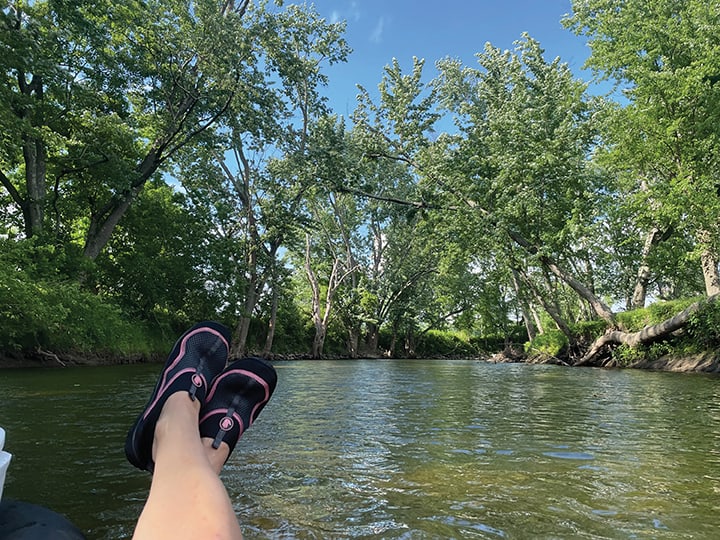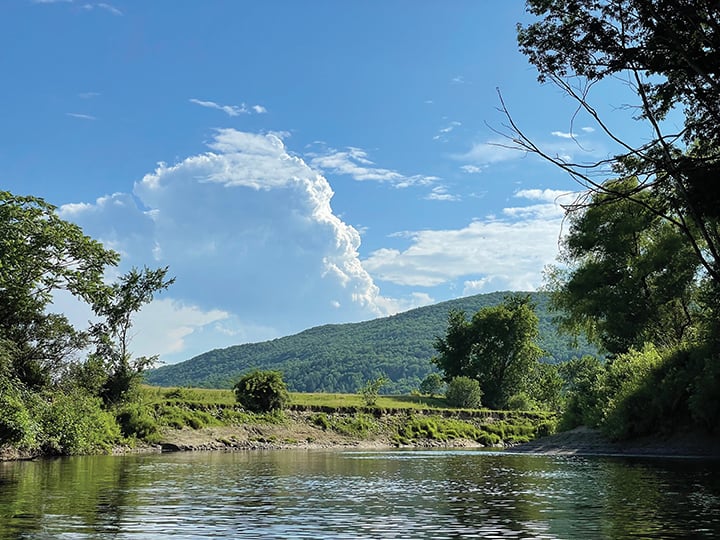For the brave, adventurous and exceedingly hot
By Brooke Geery

Floating is a classic Vermont summer activity with many different vessels to choose from. A kayak or canoe will get you there faster and keep you drier, but as the mercury tops the charts, a simple rubber innertube is the best way out of the sweaty real world and into refreshing river world. A quick disclaimer, though: tubing is a potentially hazardous activity that requires a lot more prep than you might think. It can be safe and easy, but only if done correctly. Here are some tips to get started:
Scope your route
Floating a river requires two vehicles, one at the launch and one at the take-out point. It’s important to make sure you’ll be able to not only get down to the water, but also back out when you’re done. It’s a good idea to walk down and up from your safe parking spot without any gear before you commit. Boat launches and bridges are your best bet for safe passage. It’s also important to realize that what takes you five minutes to drive, can easily take you three hours to float.
“We usually tell people to allow four hours and they always seem a little surprised,” Connecticut River-based Great River Outfitters guide Gunner Waters laughed.
Get the right tube
Unfortunately, some of central Vermont’s river floating operations are yet to recover post-pandemic. So, if renting locally isn’t an option, an inner tube from a tractor-trailer tire is the best option for insuring that your flotation vessel won’t pop if it brushes against a jagged rock or tree branch. It may be tempting to hit Walmart for a cheap tube, but the $40 investment in real rubber can make the difference between a successful float and a long wet walk.

Dress the part
Board shorts or bikinis are the desired outfit for floating, but for the fair-skinned and prone to sunburn, wearing a T-shirt overtop is a good idea. Even the strongest sunblock tends to fail when you’re literally soaking for hours — and it’s near impossible to reapply when you’re in the water. A brimmed hat can also keep your eyes from burning better than a pair of sunglasses. Most importantly, protect your toes.
“We always recommend water shoes even if it’s old sneakers,” Big Big River Tubing Owner Kirsten Dahlgren said. “It’s rocky, so if you want or need to walk, it’s good to have something on your feet.”
Bring a picnic
“People always ask if they need to eat first and I suggest, why don’t you have lunch on the river?” Dahlgren said. Whether you choose to pull off at a secluded beach and nosh sandwiches, or just snack on trail mix as you float, the easiest way to make sure your whole family stays happy is to add an additional tube for your cooler, attach it with a short rope and stock it with treats. And for the adults in your party, always bring at least one more beer per person than you’ll think you need. The river has a tendency to make you drink more than you’d expect! No matter what you bring, please pack out what you pack in following the “Leave No Trace” good Vermont protocol.
Respect the river
From your tube, you’ll see firsthand the power of Vermont’s waterways. Towering banks and exposed tree roots show the force with which the water rises and falls. A quick rain shower can literally change everything.
Wearing a life jacket is a must, because a strong current or submerged tree branch can have you upside down before you know what happened. To turn tubing from an individual to a team sport, using the right length rope to connect your tubes will create a flotilla effect that enables you to take turns paying attention and negotiating any rough spots, maximizing your overall relaxation. But only do so in calm wide waters, or someone is likely to be forced into an obstacle.
Make sure it’s hot
Even on the hottest days, tubing can be a cold activity. You’re literally going to be wet for hours, and when the sun dips behind a cloud, it can drop 20 degrees.
“I recommend not leaving until after 11 a.m. to give the mountain air a chance to warm up,” Dahlgren said. “When it’s super hot though, you can’t leave too early.”

Brooke floating with provisions at hand.
Hire a pro
Not ready to DIY your tubing experience? Get in the car and head west or south for a couple of professional operations that will rent you all the equipment and drop you off at the launch for a self-guided tubing experience that is sure to make your day. On a holiday or hot weekend, it’s best to plan a few days ahead. Midweek, though, you can decide to rent in the morning.
“People are on vacation and excited to get out there, so I do my best to accommodate them on the same day,” Dahlgren said. “But, it’s less of a scramble if you call at least the night before.”
Here are a few outfitters across Central Vermont to choose from:
Great River Outfitters
36 Park Road, Windsor
Connecticut River
Adult $27.50 or child (age 5-12) $22.50 per person
greatriveroutfitters.com
Big Big on the Battenkill
5827 VT Route 313, W. Arlington

Keep your eyes down river as you drift toward the unknown.
$30 per tube (life jacket included)
$60 per raft
$10 float for your cooler
$5 per dog life jacket
$15 to purchase water shoes (while supplies last)
bigbigonthebattenkill.com
Best floating rivers near Killington
Battenkill River: This rocky river just to the south is a favorite of Vermonters for its wide expanses and numerous covered bridges.
White River: Running alongside Route 100 through Stockbridge, this deep rock-lined basin will ensure your bathing suit remains sand-free! Put in at Rochester or the Forest Service’s Peavine beach, take out at the new bridge south of Peavine on Route 100 in Stockbridge.
Otter Creek: With its sandy bottom and somewhat secluded location, the Otter Creek which runs through Clarendon and Rutland, offers several long and short floats. Just plan on getting a little dirty in the process!
Connecticut River: Have lunch in New Hampshire and a beer in Vermont — there’s different colored mountains on each bank of this huge waterway.




